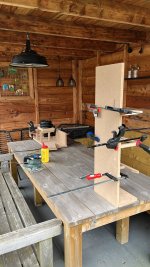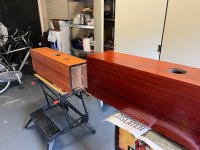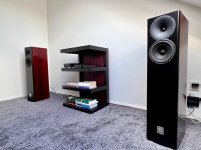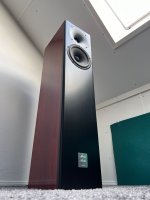Introduction
Up until now I've been mostly using mid-tier drivers and crossover components. This time I wanted to try higher-end components, to see if more expensive means more better (I'm generally skeptical about the relationship between price and performance, especially in audio).
The name (Aletheia) is derived from Greek mythology. Aletheia was personified as a Greek goddess as an embodiment of disclosure or the uncovering of truth. This fits neatly with the 'Revelator' product line of Scan-Speak (these drivers were used in this project).
Design goals
Midbass selection criteria
Tweeter selection criteria
For the midbass I chose the Scan-Speak 18W-8531G00. It has a nice combination of low-end extension, reasonable box volume (for a QB3 alignment), and sensitivity. Also, due to the paper cone, breakup is very mild. For the tweeter I ended up with the Scan-Speak D2905-950000 for its linear response, low Fs, and low distortion (as measured by AudioExcite). To which I mounted a Monacor WG-300 to control directivity, improve phase integration, and minimize edge diffraction.
The downside to adding a WG to a non-WG tweeter is of course that the response becomes very non-linear. The sound pressure increases at its lower frequencies (acoustic energy gets more focused), tapering off as frequency increases and radiation becomes more narrow (effect from the WG decreases). But this can be corrected in the crossover design. The WG was mounted to the tweeter using a custom adapter made from 9mm MDF.
I used WinISD to calculate the cabinet volume and port dimensions. I started from the QB3 alignment, but slightly reduced the cabinet volume trading a bit of extension for slightly reduced group delay. I ended up with a 35L cabinet and a theoretical -3dB at around 34Hz.
After building the box and mounting the drivers I measured each driver (gated farfield) using REW. Looking back I regret only taking measurements up to 60° off axis. I used the measured responses and impedances to design a crossover in VituixCad.
After much fiddling and a lot of help from my brother I ended up with a 3rd order on the tweeter and a 2nd order on the midwoofer. The crossover frequency is at 2100Hz, with good phase overlap around this frequency, and a decent match between the directivity of both drivers. I also incorporated an impedance correction network to mitigate a large impedance peak around the crossover frequency, which should make the speaker suitable for amps with a lower damping factor (like tube amps). I used coils (all air core) from Jantzen and Mundorf, Clarity Caps for all caps, and a Mundorf MOX resistor for tweeter attenuation.
For the finish I used a padouk wood veneer. As this type of wood is very sensitive to UV and I wanted to prevent it from greying, I applied multiple layers of UV-filtering high-gloss polyurethane. The baffle is finished using a satin black paint (many layers, with lots of sanding in between).
I'm very pleased with the result. Instruments and voices sound very lifelike. The low-end extension is impressive, but other than that it's very natural in its presentation, without emphasis on specific tonal regions.
To be honest, this experience won't stop me from using mid-tier components in the future. For me, the perceived difference in sound quality doesn't justify the difference in cost. Another factor is that I enjoy building speakers as much as listening to them (maybe even more). But I had a lot of fun building these, and will probably be using them as my main speakers for a long time.
Up until now I've been mostly using mid-tier drivers and crossover components. This time I wanted to try higher-end components, to see if more expensive means more better (I'm generally skeptical about the relationship between price and performance, especially in audio).
The name (Aletheia) is derived from Greek mythology. Aletheia was personified as a Greek goddess as an embodiment of disclosure or the uncovering of truth. This fits neatly with the 'Revelator' product line of Scan-Speak (these drivers were used in this project).
Design goals
- A 2-way floorstander that sounds AND looks great
- Linear response (40 Hz - 20 kHz ±2db)
- Controlled directivity
- Good phase integration
- Low distortion
Midbass selection criteria
- Linear response
- Minimal cone breakup, and well above the crossover frequency
- F3 < 40Hz
- Box size < 40L (for QB3)
- Good sensitivity
Tweeter selection criteria
- Linear response
- Low distortion (limited data available, using low Fs as an indicator)
For the midbass I chose the Scan-Speak 18W-8531G00. It has a nice combination of low-end extension, reasonable box volume (for a QB3 alignment), and sensitivity. Also, due to the paper cone, breakup is very mild. For the tweeter I ended up with the Scan-Speak D2905-950000 for its linear response, low Fs, and low distortion (as measured by AudioExcite). To which I mounted a Monacor WG-300 to control directivity, improve phase integration, and minimize edge diffraction.
The downside to adding a WG to a non-WG tweeter is of course that the response becomes very non-linear. The sound pressure increases at its lower frequencies (acoustic energy gets more focused), tapering off as frequency increases and radiation becomes more narrow (effect from the WG decreases). But this can be corrected in the crossover design. The WG was mounted to the tweeter using a custom adapter made from 9mm MDF.
I used WinISD to calculate the cabinet volume and port dimensions. I started from the QB3 alignment, but slightly reduced the cabinet volume trading a bit of extension for slightly reduced group delay. I ended up with a 35L cabinet and a theoretical -3dB at around 34Hz.
After building the box and mounting the drivers I measured each driver (gated farfield) using REW. Looking back I regret only taking measurements up to 60° off axis. I used the measured responses and impedances to design a crossover in VituixCad.
After much fiddling and a lot of help from my brother I ended up with a 3rd order on the tweeter and a 2nd order on the midwoofer. The crossover frequency is at 2100Hz, with good phase overlap around this frequency, and a decent match between the directivity of both drivers. I also incorporated an impedance correction network to mitigate a large impedance peak around the crossover frequency, which should make the speaker suitable for amps with a lower damping factor (like tube amps). I used coils (all air core) from Jantzen and Mundorf, Clarity Caps for all caps, and a Mundorf MOX resistor for tweeter attenuation.
For the finish I used a padouk wood veneer. As this type of wood is very sensitive to UV and I wanted to prevent it from greying, I applied multiple layers of UV-filtering high-gloss polyurethane. The baffle is finished using a satin black paint (many layers, with lots of sanding in between).
I'm very pleased with the result. Instruments and voices sound very lifelike. The low-end extension is impressive, but other than that it's very natural in its presentation, without emphasis on specific tonal regions.
To be honest, this experience won't stop me from using mid-tier components in the future. For me, the perceived difference in sound quality doesn't justify the difference in cost. Another factor is that I enjoy building speakers as much as listening to them (maybe even more). But I had a lot of fun building these, and will probably be using them as my main speakers for a long time.
Attachments
Pretty!
Do note that due to the shape of the box it is an ML-TL and not a reflex. Your simukation will likely have a tuning that is higher than optimum.
dave
Do note that due to the shape of the box it is an ML-TL and not a reflex. Your simukation will likely have a tuning that is higher than optimum.
dave



